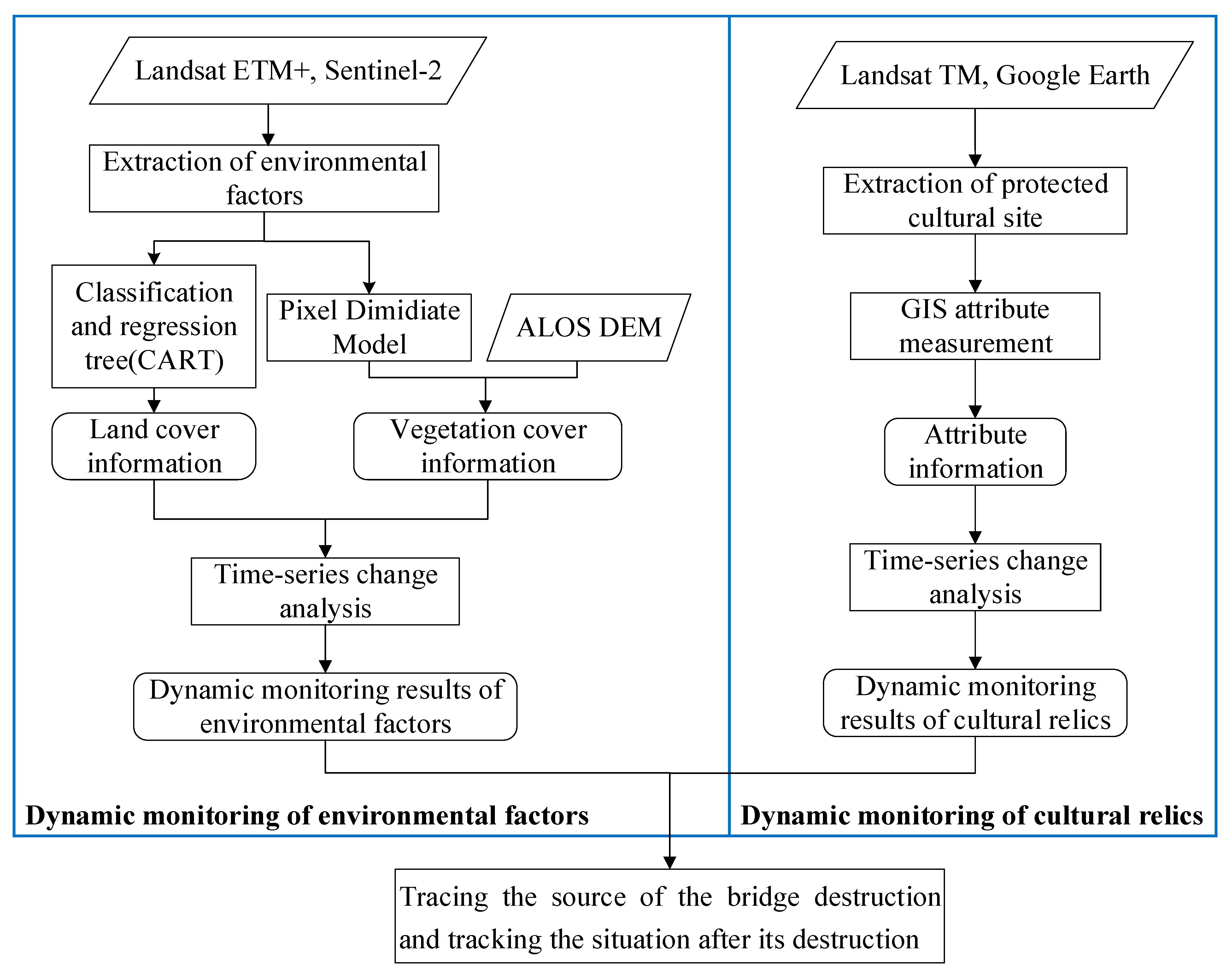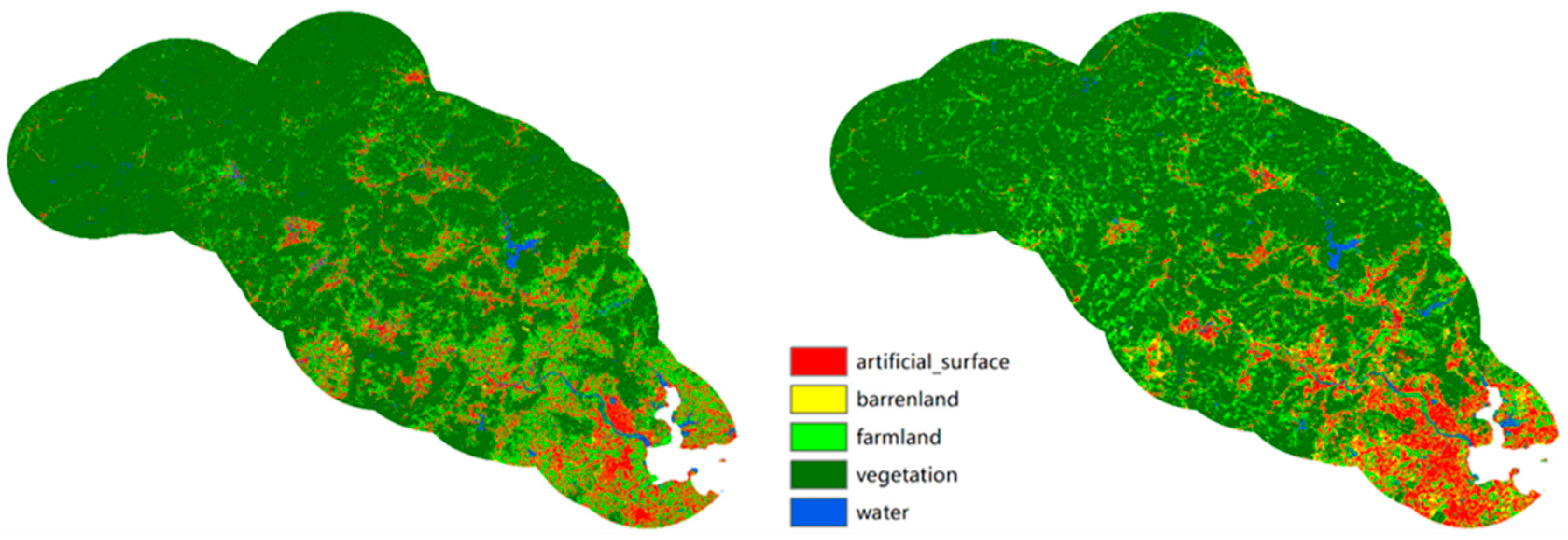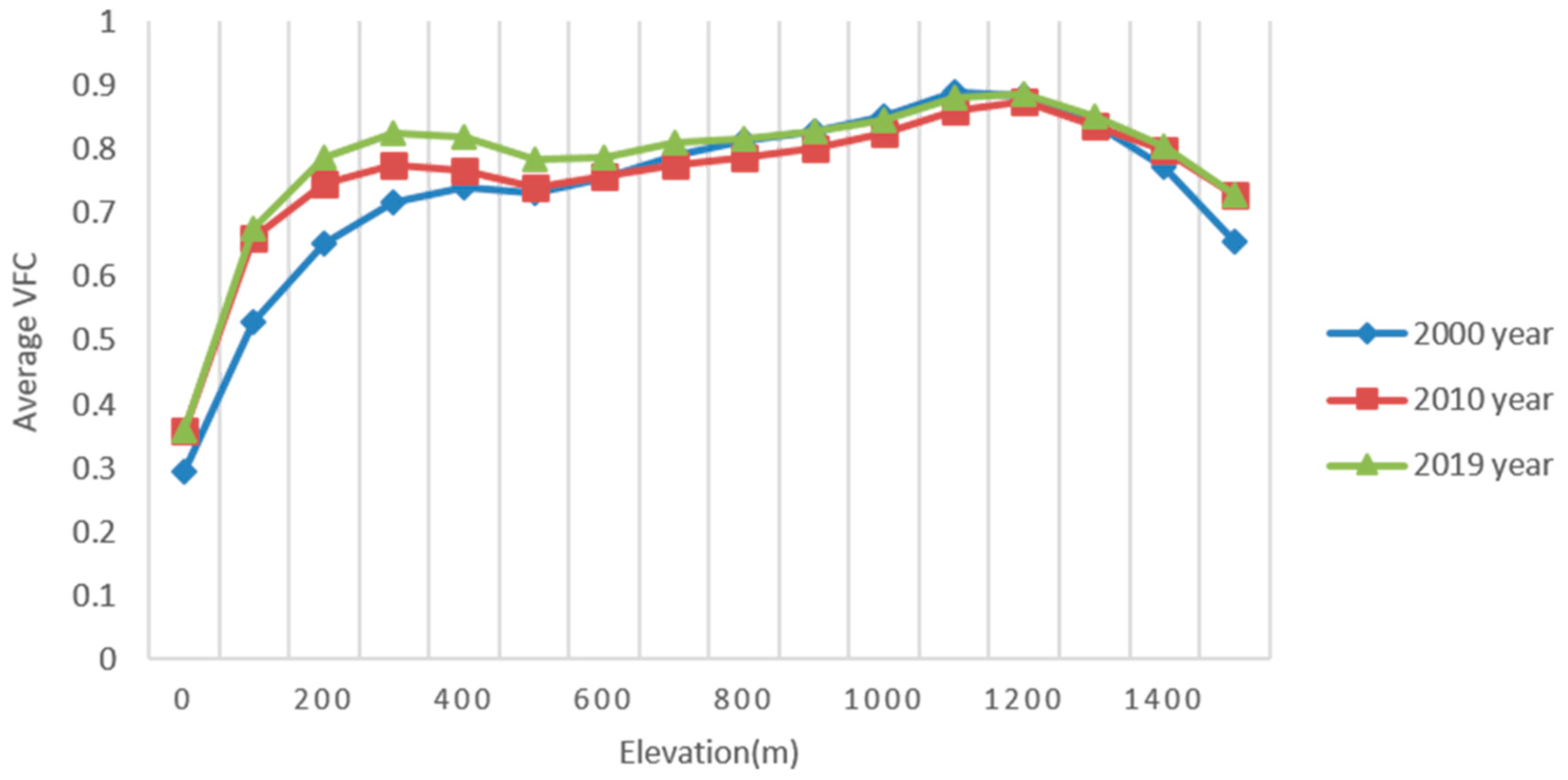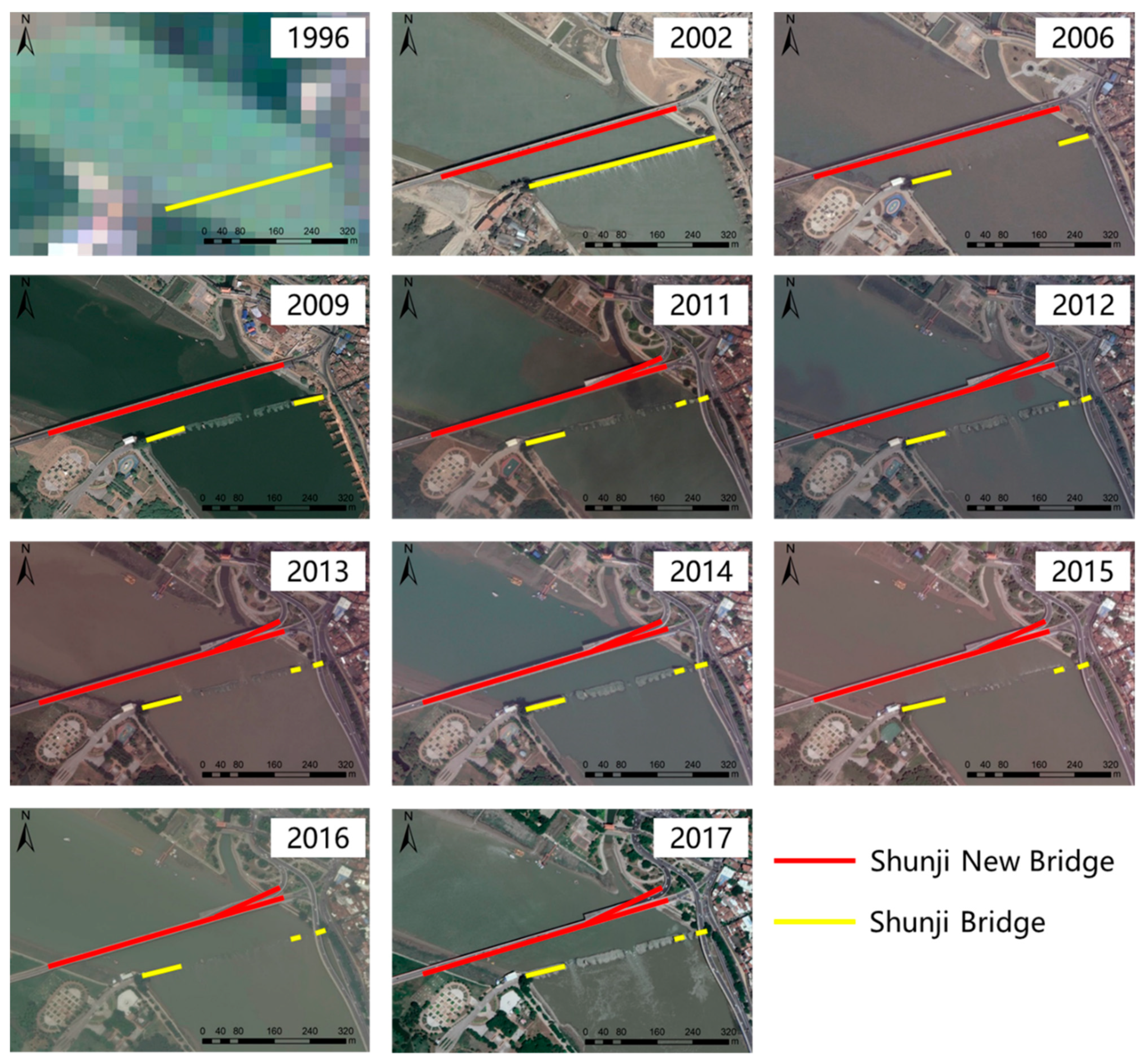Remote Sensing-Based Dynamic Monitoring of Immovable Cultural Relics, from Environmental Factors to the Protected Cultural Site: A Case Study of the Shunji Bridge
Abstract
1. Introduction
2. Materials and Methods
2.1. Study Area
2.2. Experimental Data
2.2.1. Data for Monitoring Environmental Factors
2.2.2. Data for Monitoring the Protected Cultural Site
2.3. Methods
2.3.1. Land Cover Classification
2.3.2. Vegetation Cover Information
2.3.3. Topographic Information
2.3.4. Soil Erosion Information
2.3.5. Attribute Measurement
3. Results
3.1. Results of Land Cover Classes
3.2. Results of Vegetation Cover
3.3. Results of Topography
3.4. Results of Soil Erosion
3.5. Results of Attribute Information
4. Discussion
4.1. Evaluation of Impact Factors
4.2. Efficiency in GEE
5. Findings
6. Conclusions
Author Contributions
Funding
Institutional Review Board Statement
Informed Consent Statement
Data Availability Statement
Acknowledgments
Conflicts of Interest
References
- Wang, J. Flood risk maps to cultural heritage: Measures and process. J. Cult. Herit. 2015, 16, 210–220. [Google Scholar] [CrossRef]
- Li, H.; Zhang, J.; Sun, J.; Wang, J. A visual analytics approach for flood risk analysis and decision-making in cultural heritage. J. Vis. Lang. Comput. 2017, 41, 89–99. [Google Scholar] [CrossRef]
- Haddad, N.A.; Fakhoury, L.A.; Sakr, Y.M. A Critical anthology of international charters, conventions & principles on documentation of cultural heritage for conservation, monitoring & management. Mediterr. Archaeol. Archaeom. 2021, 21, 291–310. [Google Scholar]
- Stovel, H. Risk Preparedness: A Management Manual for World Cultural Heritage; ICCROM: Rome, Italy, 1998; pp. 1–16. [Google Scholar]
- Mckercher, B.; Ho, P.S.Y.; Cros, H.D. Relationship between tourism and cultural heritage management: Evidence from Hong Kong. Tour. Manag. 2005, 26, 539–548. [Google Scholar] [CrossRef]
- Sabbioni, C.; Cassar, M.; Brimblecombe, P.; Tidblad, J.; Drdacky, M. Global climate change impact on built heritage and cultural landscapes. Int. Conf. Herit. Weather. Conserv. 2006, 1, 395–401. [Google Scholar]
- Hamilton, R.; Kucera, V.; Tidblad, J.; Watt, J. The Effects of Air Pollution on Cultural Heritage; Springer: New York, NY, USA, 2009. [Google Scholar]
- Li, G.S.; Wang, W.F.; Qu, J.J.; Song, M.H. Study on temperature and humidity environment of grotto 72 at the Mogao Grottoes in Dunhuang, China. Int. J. Climatol. 2013, 33, 1863–1872. [Google Scholar] [CrossRef]
- Ortiz, R.; Ortiz, P.; Martín, J.M.; Vázquez, M.A. A new approach to the assessment of flooding and dampness hazards in cultural heritage, applied to the historic centre of Seville (Spain). Sci. Total Environ. 2016, 1, 546–555. [Google Scholar] [CrossRef] [PubMed]
- Forino, G.; Mackee, J.; Meding, J.V. A proposed assessment index for climate change-related risk for cultural heritage protection in Newcastle (Australia). Int. J. Disaster Risk Reduct. 2016, 19, 235–248. [Google Scholar] [CrossRef]
- Oikonomopoulou, E.; Delegou, E.T.; Sayas, J.; Moropoulou, A. An innovative approach to the protection of cultural heritage: The case of cultural routes in Chios Island, Greece. J. Archaeol. Sci. Rep. 2017, 14, 742–757. [Google Scholar] [CrossRef]
- Andretta, M.; Coppola, F.; Modelli, A.; Santopuoli, N.; Seccia, L. Proposal for a new environmental risk assessment methodology in cultural heritage protection. J. Cult. Herit. 2017, 23, 22–32. [Google Scholar] [CrossRef]
- Figueiredo, R.; Romo, X.; Paupério, E. Flood risk assessment of cultural heritage at large spatial scales: Framework and application to mainland Portugal. J. Cult. Herit. 2020, 43, 163–174. [Google Scholar] [CrossRef]
- Luo, L.; Wang, X.; Guo, H.; Lasaponara, R.; Zong, X.; Masini, N.; Wang, G.; Shi, P.; Khatteli, H.; Chen, F.; et al. Airborne and spaceborne remote sensing for archaeological and cultural heritage applications: A review of the century (1907–2017). Remote Sens. Environ. 2019, 232, 232. [Google Scholar] [CrossRef]
- Lasaponara, R.; Masini, N. Satellite Remote Sensing: A New Tool for Archaeology; Springer: Heidelberg, Germany, 2012. [Google Scholar]
- Agapiou, A.; Lysandrou, V. Remote sensing archaeology: Tracking and mapping evolution in European scientific literature from 1999 to 2015. J. Archaeol. Sci. Rep. 2015, 4, 192–200. [Google Scholar] [CrossRef]
- Morehart, C.T.; Millhauser, J.K. Monitoring cultural landscapes from space: Evaluating archaeological sites in the Basin of Mexico using very high resolution satellite imagery. J. Archaeol. Sci. Rep. 2016, 10, 363–376. [Google Scholar] [CrossRef]
- Luo, L.; Wang, X.; Lasaponara, R.; Xiang, B.; Zhen, J.; Zhu, L.; Yang, R.; Liu, D.; Liu, C. Auto-extraction of linear archaeological traces of Tuntian Irrigation Canals in Miran Site (China) from Gaofen-1 satellite imagery. Remote Sens. 2018, 10, 718. [Google Scholar] [CrossRef]
- Lopes, A.S.; Macedo, D.V.; Brito, A.; Furtado, V. Assessment of urban cultural-heritage protection zones using a co-visibility-analysis tool. Comput. Environ. Urban Syst. 2019, 76, 139–149. [Google Scholar] [CrossRef]
- Choi, Y.; Yang, Y.J.; Sohn, H.G. Resilient cultural heritage through digital cultural heritage cube: Two cases in South Korea. J. Cult. Herit. 2021, 48, 36–44. [Google Scholar] [CrossRef]
- Dupont, L.; Eetvelde, V.V. Assessing the potential impacts of climate change on traditional landscapes and their heritage values on the local level: Case studies in the Dender basin in Flanders, Belgium. Land Use Policy 2013, 35, 179–191. [Google Scholar] [CrossRef][Green Version]
- Moropoulou, A.; Labropoulos, K.C.; Delegou, E.T.; Karoglou, M.; Bakolas, A. Non-destructive techniques as a tool for the protection of built cultural heritage. Constr. Build. Mater. 2013, 48, 1222–1239. [Google Scholar] [CrossRef]
- Cerra, D.; Agapiou, A.; Cavalli, R.M.; Sarris, A. An objective assessment of hyperspectral indicators for the detection of buried archaeological relics. Remote Sens. 2018, 10, 500. [Google Scholar] [CrossRef]
- Banerjee, R.; Srivastava, P.K. Reconstruction of contested landscape: Detecting land cover transformation hosting cultural heritage sites from Central India using remote sensing. Land Use Policy 2013, 34, 193–203. [Google Scholar] [CrossRef]
- Bai, X.; Du, P.; Guo, S.; Zhang, P.; Lin, C.; Tang, P.; Zhang, C. Monitoring land cover change and disturbance of the Mount Wutai world cultural landscape heritage protected area, based on remote sensing time-series images from 1987 to 2018. Remote Sens. 2019, 11, 1332. [Google Scholar] [CrossRef]
- Assassi, A.; Mebarki, A. Spatial configuration analysis via digital tools of the archeological roman town timgad, algeria. Mediterr. Archaeol. Archaeom. 2021, 21, 71–84. [Google Scholar]
- Diwan, G.A. GIS-based comparative archaeological predictive models: A first application to iron age sites in the bekaa (Lebanon). Mediterr. Archaeol. Archaeom. 2020, 20, 143–158. [Google Scholar]
- Hadjimitsis, D.; Agapiou, A.; Alexakis, D.; Sarris, A. Exploring natural and anthropogenic risk for cultural heritage in Cyprus using remote sensing and GIS. Int. J. Digit. Earth 2013, 6, 115–142. [Google Scholar] [CrossRef]
- Agapiou, A.; Lysandrou, V.; Alexakis, D.D.; Themistocleous, K.; Cuca, B.; Argyriou, A.; Sarris, A.; Hadjimitsis, D.G. Cultural heritage management and monitoring using remote sensing data and GIS: The case study of Paphos area, Cyprus. Comput. Environ. Urban Syst. 2015, 54, 230–239. [Google Scholar] [CrossRef]
- Elfadaly, A.; Eldein, A.S.; Lasaponara, R. Cultural heritage management using remote sensing data and GIS techniques around the archaeological area of Ancient Jeddah in Jeddah City, Saudi Arabia. Sustainability 2019, 12, 240. [Google Scholar] [CrossRef]
- Moise, C.; Negula, I.D.; Mihalache, C.E.; Lazar, A.M.; Dedulescu, A.L.; Rustoiu, G.T.; Inel, I.C.; Badea, A. Remote Sensing for Cultural Heritage Assessment and Monitoring: The Case Study of Alba Iulia. Sustainability 2021, 13, 1406. [Google Scholar] [CrossRef]
- Chen, W.; Huang, H.P.; Tian, Y.C.; Du, Y.Y. Monitoring and assessment of the eco-environment quality in the Sanjiangyuan region based on Google Earth Engine. J. Geo Inf. Sci. 2019, 21, 1382–1391. [Google Scholar]
- Aminzadeh, B.; Samani, F. Identifying the boundaries of the historical site of Persepolis using remote sensing. Remote Sens. Environ. 2006, 102, 52–62. [Google Scholar] [CrossRef]
- Themistocleous, K. Multi-temporal study of archaeological sites in Cyprus using atmospheric corrected satellite remotely sensed data. Int. J. Archit. Comput. 2009, 7, 121–138. [Google Scholar]
- Figorito, B.; Tarantino, E. Semi-automatic detection of linear archaeological traces from orthorectified aerial images. Int. J. Appl. Earth Obs. Geoinf. 2014, 26, 458–463. [Google Scholar] [CrossRef]
- Luo, L.; Wang, X.; Liu, C.; Guo, H.; Du, X. Integrated RS, GIS and GPS approaches to archaeological prospecting in the Hexi Corridor, NW China: A case study of the royal road to ancient Dunhuang. J. Archaeol. Sci. 2014, 50, 178–190. [Google Scholar] [CrossRef]
- Crutchley, S.; Crow, P. The Light Fantastic: Using Airborne Lidar in Archaeological Survey; English Heritage: Swindon, UK, 2010. [Google Scholar]
- Takeshi, I.; Flory, P.; Luis, R.J.; Tsuyoshi, H.; Hiroo, N.; Carlos, F.D.J.; Kazuo, A.; Hitoshi, Y. Archaeological application of airborne LiDAR with object-based vegetation classification and visualization techniques at the lowland Maya site of Ceibal, Guatemala. Remote Sens. 2017, 9, 563. [Google Scholar]
- Canuto, M.A.; Estrada-Belli, F.; Garrison, T.G.; Houston, S.D.; Acuña, M.J.; Kováč, M.; Marken, D.; Nondédéo, P.; Auld-Thomas, L.; Castanet, C.; et al. Ancient lowland Maya complexity as revealed by airborne laser scanning of northern Guatemala. Science 2018, 361, 1355. [Google Scholar] [CrossRef] [PubMed]
- Vinci, G.; Bernardini, F. Reconstructing the protohistoric landscape of Trieste Karst (north-eastern Italy) through airborne LiDAR remote sensing. J. Archaeol. Sci. Rep. 2017, 12, 591–600. [Google Scholar]
- Trier, I.D.; Reksten, J.H.; Lseth, K. Automated mapping of cultural heritage in Norway from airborne LiDAR data using faster R-CNN. Int. J. Appl. Earth Obs. Geoinf. 2021, 95, 102241. [Google Scholar] [CrossRef]
- Tsiafaki, D.; Michailidou, N. Benefits and problems through the application of 3d technologies in archaeology: Recording, visualisation, representation and reconstruction. Sci. Cult. 2015, 1, 37–45. [Google Scholar]
- Hatzopoulos, J.N.; Stefanakis, D.; Georgopoulos, A.; Tapinaki, S.; Pantelis, V.; Liritzis, I. Use of various surveying technologies to 3d digital mapping and modelling of cultural heritage structures for maintenance and restoration purposes: The tholos in DELPHI, GREECE. Mediterr. Archaeol. Archaeom. 2017, 17, 311–336. [Google Scholar]
- Altuntas, C.; Hezer, S.; Kırlı, S. Image based methods for surveying heritage of masonry arch bridge with the example of dokuzunhan in konya, Turkey. Sci. Cult. 2017, 3, 13–20. [Google Scholar]
- Vilbig, J.M.; Sagan, V.; Bodine, C. Archaeological surveying with airborne LiDAR and UAV photogrammetry: A comparative analysis at Cahokia Mounds. J. Archaeol. Sci. Rep. 2020, 33, 102509. [Google Scholar] [CrossRef]
- Su, T.C. Environmental risk mapping of physical cultural heritage using an unmanned aerial remote sensing system: A case study of the Huang-Wei monument in Kinmen, Taiwan. J. Cult. Herit. 2019, 39, 140–151. [Google Scholar] [CrossRef]
- Zhen, J.; Wang, X.; Meng, Q.; Song, J.; Ying, L.; Bo, X.; Guo, H.; Liu, C.; Yang, R.; Lei, L. Fine-Scale Evaluation of Giant Panda Habitats and Countermeasures against the Future Impacts of Climate Change and Human Disturbance (2015–2050): A Case Study in Ya’an, China. Sustainability 2018, 10, 1081. [Google Scholar] [CrossRef]
- Roy, N.; Pandey, B.W.; Rani, U. Protecting the vanishing geo-cultural heritage of India: Case study of Majuli Island in Assam. Int. J. Geoheritage Parks 2020, 8, 18–30. [Google Scholar] [CrossRef]
- Iriarte, E.; Sánchez, M.Á.; Foyo, A.; Tomillo, C. Geological risk assessment for cultural heritage conservation in karstic caves. J. Cult. Herit. 2010, 11, 250–258. [Google Scholar] [CrossRef]
- Rodríguez-Rosales, B.; Abreu, D.; Ortiz, R.; Becerra, J.; Cepero-Acán, A.E.; Vázquez, M.A.; Ortiz, P. Risk and vulnerability assessment in coastal environments applied to heritage buildings in Havana (Cuba) and Cadiz (Spain). Sci. Total Environ. 2021, 750, 141617. [Google Scholar] [CrossRef]
- Nebbia, M.; Cilio, F.; Bobomulloev, B. Spatial risk assessment and the protection of cultural heritage in southern Tajikistan. J. Cult. Herit. 2021. [Google Scholar] [CrossRef]
- Friedl, M.A.; Brodley, C.E. Decision tree classification of land cover from remotely sensed data. Remote Sens. Environ. 1997, 61, 399–409. [Google Scholar] [CrossRef]
- Deardorff, J.W. Efficient prediction of ground surface temperature and moisture, with inclusion of a layer of vegetation. J. Geophys. Res. 1978, 83, 1889–1904. [Google Scholar] [CrossRef]
- Gutman, G.; Ignatov, A. The derivation of the green vegetation fraction from NOAA/AVHRR data for use in numerical weather prediction models. Int. J. Remote Sens. 1998, 19, 1533–1543. [Google Scholar] [CrossRef]
- Zhang, M.; Wang, J.; Li, S. Tempo-spatial changes and main anthropogenic influence factors of vegetation fractional coverage in a large-scale opencast coal mine area from 1992 to 2015. J. Clean. Prod. 2019, 232, 940–952. [Google Scholar] [CrossRef]
- Song, Y.; Lu, Y.; Liu, T.; Li, H.; Yue, Z.; Liu, H.; Gao, T. Variation of vegetation fractional coverage and its relationship with climate in a desert steppe: Optimization of farmland layout in a farming–pastoral ecotone using the ecological suitability index. Ecol. Eng. 2020, 150, 105834. [Google Scholar] [CrossRef]
- Ministry of Water Resources, PRC. Soil Erosion Classification and Grading Standards, SL190-2007; China Water Power Press: Beijing, China, 2008. [Google Scholar]
- Hu, Z.; He, F.; Yin, J.; Lu, X.; Tang, S.; Wang, L.; Li, X. Estimation of fractional vegetation cover based on digital camera survey data and a remote sensing model. J. China Univ. Min. Technol. 2007, 1, 116–120. [Google Scholar] [CrossRef]
- Wang, F.; Yeap, S.P. Using magneto-adsorbent for methylene Blue removal: A decision-making via analytical hierarchy process (AHP). J. Water Process Eng. 2021, 40, 101948. [Google Scholar] [CrossRef]
- Saaty, R.W. The analytic hierarchy process—What it is and how it is used. The analytic hierarchy process. Math. Model. 1987, 9, 161–176. [Google Scholar] [CrossRef]













| Data | Spatial Resolution | Acquisition Time | Purpose |
|---|---|---|---|
| Landsat-7 ETM+ | 30 m | September to November 2000, 2010 | Land cover classification and vegetation cover information extraction. |
| Sentinel-2 | 10 m | September to November 2019 | |
| ALOS DEM | 12.5 m | 2007 | Topographic information extraction. |
| Data | Spatial Resolution | Acquisition Time | Purpose |
|---|---|---|---|
| Landsat-5 TM | 30 m | 1996 | Attribute information measurement. |
| Google Earth | 0.27 m | 2002, 2006, 2009, 2011, 2012, 2013, 2014, 2015, 2016, 2017 |
| Classification | Description of Characteristics |
|---|---|
| Artificial surface | Including residential, commercial, industry, public, traffic networks such as roads and bridges. |
| Barren land | Mainly including bare soil. |
| Farmland | Cultivatable land. |
| Vegetation | Including woodland, grassland, shrubland and green belt in the urban areas. |
| Water | Including rivers, ponds, lakes and canals. |
| Slope | 0–5° | 5–8° | 8–15° | 15–25° | 25–35° | >35° | |
|---|---|---|---|---|---|---|---|
| FVC | |||||||
| 0.75–1.00 | Mild | Mild | Mild | Mild | Mild | Mild | |
| 0.60–0.75 | Mild | Mild | Mild | Mild | Mild | Moderate | |
| 0.45–0.60 | Mild | Mild | Mild | Mild | Moderate | Strong | |
| 0.30–0.45 | Mild | Mild | Mild | Moderate | Strong | Extremely strong | |
| 0.00–0.30 | Mild | Mild | Moderate | Strong | Extremely strong | Severe | |
| Data | Gapfill | Atmospheric Correction | Mosaic | Subset | Classification and NDVI Information Extraction | ||
|---|---|---|---|---|---|---|---|
| Time | ENVI | 2.5 h | 4 h | 18 h | 20 h | 0.4 h | 1.8 h |
| GEE | The total time is approximately 0.26 h. | ||||||
| RAM | ENVI | 5.6 GB | 4.9 GB | 5.1 GB | 5.2 GB | 3.3 GB | 0.64 GB |
| GEE | 0 | 0.06 GB | |||||
| Data | Resampling | Mosaic | Subset | Classification and NDVI Information Extraction | ||
|---|---|---|---|---|---|---|
| Time | SNAP | 3.5 h | 12 h | 15 h | 4 h | 2.4 h |
| GEE | The total time is approximately 0.29 h. | |||||
| RAM | SNAP | 5.1 GB | 43.2 GB | 43.1 GB | 35.6 GB | 1.21 GB |
| GEE | 0 | 0.29 GB | ||||
Publisher’s Note: MDPI stays neutral with regard to jurisdictional claims in published maps and institutional affiliations. |
© 2021 by the authors. Licensee MDPI, Basel, Switzerland. This article is an open access article distributed under the terms and conditions of the Creative Commons Attribution (CC BY) license (https://creativecommons.org/licenses/by/4.0/).
Share and Cite
Liu, Y.; Tang, Y.; Jing, L.; Chen, F.; Wang, P. Remote Sensing-Based Dynamic Monitoring of Immovable Cultural Relics, from Environmental Factors to the Protected Cultural Site: A Case Study of the Shunji Bridge. Sustainability 2021, 13, 6042. https://doi.org/10.3390/su13116042
Liu Y, Tang Y, Jing L, Chen F, Wang P. Remote Sensing-Based Dynamic Monitoring of Immovable Cultural Relics, from Environmental Factors to the Protected Cultural Site: A Case Study of the Shunji Bridge. Sustainability. 2021; 13(11):6042. https://doi.org/10.3390/su13116042
Chicago/Turabian StyleLiu, Yanzhen, Yunwei Tang, Linhai Jing, Fulong Chen, and Ping Wang. 2021. "Remote Sensing-Based Dynamic Monitoring of Immovable Cultural Relics, from Environmental Factors to the Protected Cultural Site: A Case Study of the Shunji Bridge" Sustainability 13, no. 11: 6042. https://doi.org/10.3390/su13116042
APA StyleLiu, Y., Tang, Y., Jing, L., Chen, F., & Wang, P. (2021). Remote Sensing-Based Dynamic Monitoring of Immovable Cultural Relics, from Environmental Factors to the Protected Cultural Site: A Case Study of the Shunji Bridge. Sustainability, 13(11), 6042. https://doi.org/10.3390/su13116042








